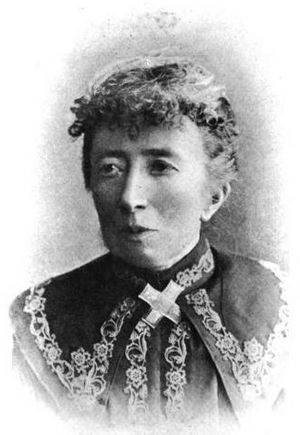Agnes Mary Clerke facts for kids
Quick facts for kids
Agnes Mary Clerke
|
|
|---|---|
 |
|
| Born | 10 February 1842 Skibbereen, County Cork, Ireland
|
| Died | 20 January 1907 (aged 64) London
|
Agnes Mary Clerke (born February 10, 1842 – died January 20, 1907) was an amazing Irish astronomer and writer. She was born in Skibbereen, County Cork, Ireland, and later passed away in London. Agnes was known for her many writings about astronomy, making complex ideas easier for people to understand.
Contents
Her Family and Early Learning
Agnes Clerke grew up with her parents, John William Clerke and Catherine Mary Deasy. Her father was a bank manager. Agnes had an older sister, Ellen Mary, and a younger brother, Aubrey St. John. All three children were taught at home. Their mother, Catherine, believed strongly in educating girls. This focus on learning helped Agnes develop her talents from a young age.
Agnes's Journey in Astronomy
Agnes became interested in astronomy very early, just like her father. She used her father's 4-inch telescope to observe the stars. By the age of 15, she had already started writing a history of astronomy.
Moving and Studying
In 1861, when Agnes was 19, her family moved to Dublin. Two years later, in 1863, they moved to Cobh (which was then called Queenstown). At 25, Agnes and her older sister Ellen moved to Italy. They stayed there until 1877, mostly in Florence. During this time, they studied science, languages, and other subjects that would help them later in life. In 1877, Agnes settled in London.
Becoming a Published Writer
After returning to London, Agnes got two articles published in the Edinburgh Review. These articles were about "Brigandage in Sicily" and "Copernicus in Italy." This success led to a big opportunity. The publishers of the Review, who also published the Encyclopædia Britannica, asked her to write about famous scientists for their ninth edition.
This led to many more writing jobs. She even wrote the article about astronomy for the Catholic Encyclopedia. Agnes also reviewed many books, including some written in French, German, Greek, or Italian.
Her Famous Book and Awards
In 1885, Agnes published her most well-known book, A Popular History of Astronomy during the Nineteenth Century. This book helped many people understand astronomy better.
In 1890, Agnes and her brother Aubrey helped start the British Astronomical Association. Her sister, Ellen, also wrote about astronomy.
In 1893, Agnes received the Actonian Prize, which was a special award of 100 guineas from the Royal Institution. She regularly attended meetings of the British Astronomical Association and the Royal Astronomical Society. In 1903, Agnes and Margaret Lindsay Huggins were made honorary members of the Royal Astronomical Society. Before them, only three other women had received this honor: Caroline Herschel, Mary Somerville, and Anne Sheepshanks.
Her Personal Life
Agnes and Ellen were very religious Catholics throughout their lives. Neither sister ever married.
Her Lasting Impact
Agnes Mary Clerke's work left a lasting mark on astronomy. The lunar crater Clerke on the Moon is named after her.
In 2002, Mary Brück wrote a book about Agnes called Agnes Mary Clerke and the Rise of Astrophysics.
In 2017, the Royal Astronomical Society created the Agnes Clerke Medal. This medal is given to people who have done amazing research into the history of astronomy or geophysics. The first person to receive this award was Clive Ruggles.
Selected Writings
Agnes wrote 55 articles for the Edinburgh Review, mostly about astrophysics. She also wrote articles for the Dictionary of National Biography, the Encyclopædia Britannica, and the Catholic Encyclopedia. Her articles in the ninth edition of the Britannica included entries on Galileo Galilei, Alexander von Humboldt, Johannes Kepler, Antoine Lavoisier, and the zodiac.
See Also
 In Spanish: Agnes Mary Clerke para niños
In Spanish: Agnes Mary Clerke para niños

